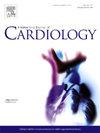Predicting prolonged length of in-hospital stay in patients with non-ST elevation myocardial infarction (NSTEMI) using artificial intelligence
IF 3.2
2区 医学
Q2 CARDIAC & CARDIOVASCULAR SYSTEMS
引用次数: 0
Abstract
Background
Patients presenting with non-ST elevation myocardial infarction (NSTEMI) are typically evaluated using coronary angiography and managed through coronary revascularization. Numerous studies have demonstrated the benefits of expedited discharge following revascularization in this patient population. However, individuals with concomitant heart failure, hemodynamic instability, or arrhythmias often necessitate prolonged hospitalization. Using aortic pressure (AP) wave assessment, we aim to predict a prolonged length of stay (> 4 days, PLoS) in patients with NSTEMI treated with percutaneous coronary intervention (PCI).
Methods
In this single-center, retrospective cohort study, we included 497 patients with NSTEMI [66.3 ± 12.9 years, 37.6 % (187) females]. We developed a predictive model for PLoS using features primarily extracted from the AP signal recorded throughout PCI. We performed feature selection using recursive feature elimination (RFE) with cross-validation and built a machine learning (ML) model using the CatBoost tree-based classifier. The decision-making process of the ML model was analyzed using SHapley Additive exPlanations (SHAP).
Results
We achieved average accuracy, specificity, sensitivity, precision, and receiver operating characteristic curve area under the curve (AUC) values of 77 %, 78 %, 76 %, 67 %, and 77 %, respectively. Using SHAP, we identified the ejection systolic period, ejection systolic time, the difference between systolic blood pressure and dicrotic notch pressure (DesP), the age modified shock index (mSI_age) and mean arterial pressure (MAP) as the most characteristic features extracted from the AP signal.
Conclusions
In conclusion, this study demonstrates the potential of using ML and features extracted from the AP signal to predict PLoS in patients with NSTEMI.

应用人工智能预测非st段抬高型心肌梗死(NSTEMI)患者住院时间延长
背景:非st段抬高型心肌梗死(NSTEMI)患者通常通过冠状动脉造影进行评估,并通过冠状动脉血运重建术进行治疗。大量的研究已经证明,加快出院后的血运重建术在这一患者群体的好处。然而,伴有心力衰竭、血流动力学不稳定或心律失常的患者往往需要长期住院治疗。通过主动脉压(AP)波评估,我们的目标是预测延长的住院时间(>;经皮冠状动脉介入治疗(PCI)治疗的非stemi患者的4天,PLoS)。方法在这项单中心、回顾性队列研究中,我们纳入了497例NSTEMI患者[66.3±12.9岁,37.6%(187例)女性]。我们开发了PLoS的预测模型,主要使用从PCI过程中记录的AP信号中提取的特征。我们使用递归特征消除(RFE)和交叉验证进行特征选择,并使用基于CatBoost树的分类器构建机器学习(ML)模型。采用SHapley加性解释(SHAP)对ML模型的决策过程进行分析。结果平均准确度、特异度、灵敏度、精密度和受试者工作特征曲线下面积(AUC)分别为77%、78%、76%、67%和77%。利用SHAP,我们确定了射血收缩期、射血收缩期、收缩压与双侧陷波压之差(DesP)、年龄修正休克指数(mSI_age)和平均动脉压(MAP)作为从AP信号中提取的最具特征的特征。总之,本研究证明了利用ML和从AP信号中提取的特征来预测NSTEMI患者的PLoS的潜力。
本文章由计算机程序翻译,如有差异,请以英文原文为准。
求助全文
约1分钟内获得全文
求助全文
来源期刊

International journal of cardiology
医学-心血管系统
CiteScore
6.80
自引率
5.70%
发文量
758
审稿时长
44 days
期刊介绍:
The International Journal of Cardiology is devoted to cardiology in the broadest sense. Both basic research and clinical papers can be submitted. The journal serves the interest of both practicing clinicians and researchers.
In addition to original papers, we are launching a range of new manuscript types, including Consensus and Position Papers, Systematic Reviews, Meta-analyses, and Short communications. Case reports are no longer acceptable. Controversial techniques, issues on health policy and social medicine are discussed and serve as useful tools for encouraging debate.
 求助内容:
求助内容: 应助结果提醒方式:
应助结果提醒方式:


